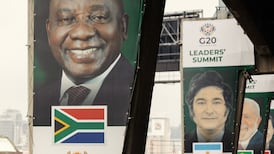There's something otherworldly about the gothic colossus that is Cologne cathedral. Crossing a bridge over the river Rhine on a cold winter evening, most of the cityscape is a well-illuminated mishmash of pre- and post-war architecture with clear features and lines.
But looming up behind, like a still from Fantasia's Night on Bald Mountain, the hazy facade of the twin-turreted Dom looks like it is occupying another dimension. For such a massive building, it's surprising how few people know why the cathedral is there at all.
It is the last resting place of the Magi, the three wise men said to have paid homage to the baby Jesus in Bethlehem. Known to their friends as Caspar, Melchior and Balthasar, the gospel of St Matthew records their trip across the desert following a bright star in the sky.
On a pitstop in Jerusalem they asked King Herod if he knew where they should head next. Herod mentioned the prophecy of the Messiah being born in Bethlehem and asked them to return and tell him if and where they found him. The trio found the baby Jesus and, according to the Gospel, presented him with gifts of gold, frankincense and myrrh.
Herod
Sensing in a dream that Herod had other plans for Jesus than another gift, the three bypassed Jerusalem on their way home. And that is that, as far as the trio’s Bible appearance goes. Except the story didn’t end there. When they died, it is said that their bones – skulls and all – were discovered in Persia by Helena, mother of emperor Constantin, and taken to Constantinople.
Then they were entrusted to Bishop Eustorgius I of Milan, who brought them to the then Lombardian city in the fifth century. Finally Frederick Barbarossa, the Holy Roman Emperor and, later, ruler of Lombardy, entrusted the relics to Archbishop of Cologne Rainald of Dassel in 1164 – 850 years ago. He decided that Cologne, as new home for the three men's remains, deserved the biggest cathedral in the world.
Construction work began in 1248 and was completed 632 years later in 1880. It remains the largest gothic church in northern Europe while the shrine for the Magi the largest of its kind. A large golden box in the shape of a basilica, it is 1.5 metres long and roughly one metre high and wide. It is a glorious explosion of gold, bronze, ivory and precious jewels, designed in part by medieval goldsmith Nicholas of Verdun.
Dozens of panels tell the life of Christ, stories of the prophets and of the apostles. The shrine was completed after 45 years, in 1225. It was more than six centuries until the shrine was opened again and its contents documented. In 1864 Archbishop Philip discovered “the remains of ancient rotten or moulded bandages . . . and numerous bones of three persons” as well as coins, swords and croziers.
His assistants reassembled the bones into nearly complete bodies: one was clearly of a youth, the second of a young man, the third of an old man. The bones were wrapped in white silk, according to contemporaneous reports, and returned to the shrine.
Over the subsequent centuries, the Magi shrine in Cologne has become a huge draw for pilgrims from over the world. Milan still has hopes it will get them back but Cologne refuses to budge. No wonder: though severe wartime bombing almost levelled the city, the shrine and the cathedral survived almost unscathed.
Three crowns
The Magi are today a crucial part of local identity and their three crowns adorn the city seal. For this (850th) anniversary year a special exhibition in Cologne explains how a brief mention in Mathew’s Gospel was embellished and the men made into kings by monarchs anxious to establish a link, however tenuous, back to the three – and to the Son of God.
So what is inside the shrine? A collection of bones from a 12th-century hoax, as Umberto Eco suggests in his book Baudolino, or the real deal? Walk to the back of Cologne cathedral and you'll see that the front panel of the shrine – usually removed only on January 6th each year, the feast of the Epiphany – has been left off for the anniversary year.
Squint past the golden mesh that covers the opening and you can see the outline of three skulls adorned with crowns, added later. “No one can prove the bones are theirs, but no one can prove they aren’t theirs,” says Jean-Bruno Broicher, a local art historian and cathedral guide.
An investigation carried out in 1980 revealed that material attached to the bones was silk, certainly fancy enough to have been worn by kings or noble men, and dating from in modern-day Syria about 2,000 years ago. But for Cologne dwellers, the magic of the holy Magi is not about proof, but belief. "For me, it is important to believe," said Broicher, "and I don't see why not."











